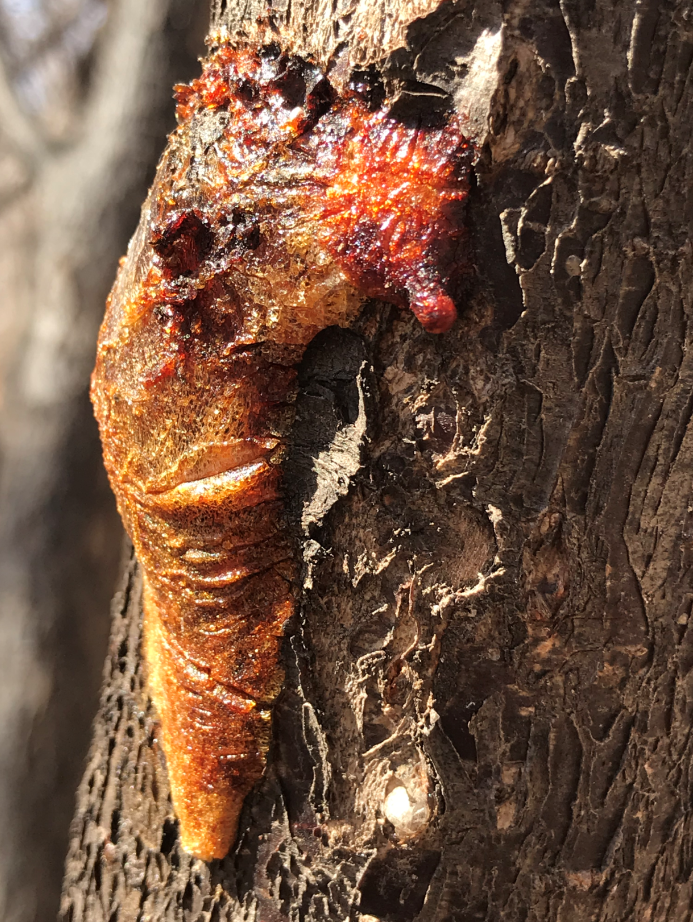Southwest Yard & Garden – Diagnosing Trees with Oozing Sap… Again

Reddish sap oozing from a plum tree at Bachechi Open Space in Albuquerque, March 2021. Photo credit M. Rehn.
(but this time, the sap is reddish-orange and doesn’t stink!)
Question: Any idea what may be causing the sap to run out of some of these plum trees in the arboretum at Bachechi Open Space?
– Dustin C., Albuquerque
Answer: This is turning out to be another one of those common questions that come in from all parts of the state. In the past two weeks, I’ve gotten photos of orange or red sap oozing from plum trees and a redbud in the Albuquerque area, an ash in Las Cruces, and I’ve taken a ton of pictures of plum, cherry, and peach trees with similar globs that have hardened after a few years in the sun. Are these weird amber blobs caused by borers or a plant pathogen? Or both? How do you tell? And what can be done about either?
We learned about the peach tree borer back in March 2018:
The greater peach tree borer (Synanthedon exitiosa) is known for causing oozing trunk wounds found at ground level or just below the soil line on stone fruit trees. The sap is often clear, but sawdust frass produced by the borer can be mixed in, giving it a darker color. Stone fruits are named for the pit, or “stone,” that encloses the seed; they include peaches, nectarines, plums, cherries, almonds, and others…
Besides a late freeze, the peach tree borer (also spelled peachtree borer) is the worst threat to stone fruits in New Mexico. Dr. Carol Sutherland, NMSU Extension Entomology Specialist and NMDA Entomologist [recently retired—CONGRATULATIONS!], says peach tree owners need to be aware that “everybody will have peach tree borer sooner or later, and if you do nothing it will kill your tree.”
Plant stress can be an invitation to pests, which are more likely to attack when the immune systems are weak…
Now let’s learn about cytospora canker, a fungal pathogen that is frequently found in New Mexico in woody tissue in poplars, willows, fruit trees, and many others. I reached out for help understanding cytospora vs. borer symptoms.
Phillip Lujan, Diagnostician for NMSU’s Plant Diagnostic Clinic (https://plantclinic.nmsu.edu), pointed out that it’s sometimes hard to distinguish between cytospora canker and borer damage without checking closely for borer holes. And it very well could be a combination of both. Lujan expressed concern that already this season, the NMSU Plant Diagnostic Clinic has received samples and photos of stressed trees. He adds that the prevalence of ooze in late winter and early spring is likely related to the trees starting to emerge from dormancy; as trees bud out and the sap starts moving again, they may be oozing more than at other times of the year.

Cytospora canker sap leaking from the bark of an ash tree in Las Cruces, March 2021. Photo credits P. Lujan.
Last summer, Lujan diagnosed cytospora canker in aspens in Albuquerque and Angel Fire and in cottonwoods in Socorro and Roswell. “This fungus is a relatively weak pathogen, which typically attacks stressed trees. Some symptoms of infection include circular, elongated, or irregular-shaped cankers, which first appear on infected trees as brown, slightly sunken areas in the bark of branches and trunks. As the canker enlarges, the outer bark may become black, brown, gray, reddish-brown, or yellow. The inner bark turns reddish-brown to black. The best management is to prevent infection by keeping trees from becoming stressed. Maintain good watering practices and prune out injured branches as they occur. On infected trees, remove all dead and dying branches. Do not prune trees when the bark is wet. There are no fungicides currently available for controlling cytospora, but again, this is a relatively weak pathogen.”
This bears repeating: As with many insect problems, trees that are already stressed are more likely to have problems with cytospora canker and other pathogens. Trees exhibiting cytospora canker symptoms, like the reddish ooze on tree trunks in these photos, may continue to live and even thrive, providing fruit and shade for many years, as long as the underlying stressors are alleviated. These are most commonly root restrictions (including girdling roots and compacted soils) and drought stress.
Last summer, I missed the chance to write about cytospora ooze and instead focused on slimeflux, a stinkier, but no less prevalent, tree trunk problem. For more on slimeflux, peach tree borers, and links to more amazing cytospora photos and info, visit the blog version of this column. I’ve also linked a fun video that starts with beautiful fruit tree flower buds and ends with me using my thumb to scrape a dried clump of orange sap from the bark of a cherry tree to look for borer hole evidence underneath.

Oozing sap on an aspen tree diagnosed with cytospora canker in Sandia Park, May 2020. Photo credit J. Smith.
For more gardening information, visit the NMSU Extension Horticulture page at Desert Blooms (http://desertblooms.nmsu.edu/) and the NMSU Horticulture Publications page at http://aces.nmsu.edu/pubs/_h/. Find your local Cooperative Extension Office at https://aces.nmsu.edu/county/.
Dr. Marisa Y. Thompson, Ph.D., is the Extension Urban Horticulture Specialist in the Department of Extension Plant Sciences and is based at the New Mexico State University Agricultural Science Center at Los Lunas.
